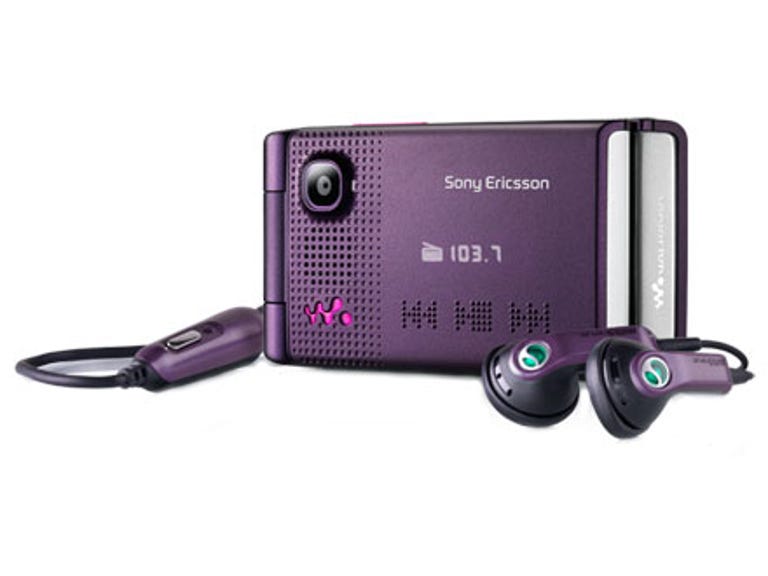 Why You Can Trust CNET
Why You Can Trust CNET Sony Ericsson W380i review: Sony Ericsson W380i
Sony Ericsson's W380i is pretty much an MP3 player wrapped around a mobile phone — and a pretty darned good MP3 player at that.
Design
The W380i is the latest in Sony Ericsson's line-up of Walkman phones. Featuring a clamshell form factor, the W380i is an understated, entry-level mobile phone available in magnetic grey or electric purple.
The Good
The Bad
The Bottom Line
While the flip phone's outer shell appears nondescript, on closer inspection hidden underneath the grey cover is an OLED screen that is visible when closing the clamshell or when selecting music in MP3 player mode. The information displayed is quite similar to Sony Ericsson's Z750i where information displayed includes battery life, missed call/message, time and reception levels.
Side on, the W380i is a parallelogram with just one proprietary port for hooking up the included stereo hands-free headphones, AC adapter and USB cable; on the opposite side is the volume button.
Opened up, the clamshell phone sports a nice clean design with soft keys shaped like little silver discs and a bright aqua jewel-like button at the centre of the five-way navigation disc. The tactile keys on the number pad are attractively rounded bubble-like keys that are easy to press and provide good tactile feedback.
Turning the phone over, there is a small sliding lock ... you'll have to read on to find out what this mystery button does.
Features
There are quite a few features on the W380i, like a 1.3-megapixel camera with 4x digital zoom, Bluetooth stereo, RSS reader and the usual assortment of apps such as calculator, alarm clock, etc.
What interested us the most was the Gesture control, which sets this phone apart from other models in Sony Ericsson's Walkman line-up. What's Gesture control, you ask? Quite simply it's a way to control your phone by waving your hand in front of the embedded camera lens.
Unfortunately, there's not a lot you can do with gesture control. You can mute incoming calls or put your alarm on snooze — that's about it. (We also found that it took quite a few waves of the hand before it mutes or snoozes. In that amount of time, we could've pressed a button — and not look like a fool). A few onlookers mistakenly thought we were trying to answer the phone by waving hello. And if you think jiggling it around in your pocket will do the job, it doesn't.
Also, if you were to use it to turn off your alarm, you'd probably knock over everything on your bedside table before the alarm turns off. It's a gimmick you probably won't use after the first few days of purchasing the phone.
A really nice feature, however, are the play, fast forward and rewind braille-like buttons at the top of the phone. To activate these, you slide the lock button located at the back of the phone and it's ready to go. By touching one of the markings, the W380i will give a little buzz to acknowledge you've hit one of the buttons. And with the volume button on the side, you won't have to open the phone to control your music. Song information scrolls across the top of the phone, which is handy for flipping through your song selection.
The W380i has a tiny 14MB of internal storage with an included 512MB Memory Stick Micro (M2) — there's the option to expand up to 2GB for your expansive music library. To access the M2, the somewhat flimsy back cover must be removed first.
If you're concerned about using the phone abroad, the W380i is tri-band GSM (900/1800/1900MHz) compatible, and runs on EDGE and GPRS data networks.
Performance
Music played on the phone's built-in speaker was incredibly tinny with no bass and average treble, even after adjusting the equaliser settings. The volume was loud enough for you to hear the music from across a quiet room, but don't expect to hear it in a noisy environment without headphones.
Listening to music via the included headphones improved things greatly. The equaliser settings were quite impressive. After playing around with this feature, you'd never want to listen to music without "Mega Bass", or if you're a great fan of a singer's voice but the music drowns it out, you can select the "Voice" setting. You can also choose to listen to music in Normal, Bass and Treble Boost modes.
Calls came through nice and clear. We found it very easy to hear the caller, even in a noisy environment.
We experienced a few difficulties with the operating system — it was noticeably slow. The phone took a slow second to react when we pressed the soft keys and navigation key, but things went much more quickly when we got into the sub-structure.
Battery life lasted for approximately 8.5 hours of non-stop music and the occasional phone call, which is one hour and a half longer than the company's estimated time of seven hours. According to Sony Ericsson, the W380i will last for approximately 300 hours on standby.
If you're after a pretty decent MP3 player that just so happens to be a pretty nice phone, then we highly recommend the W380i.
